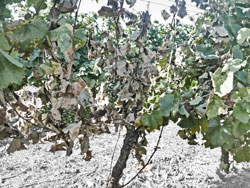Esca
- 16 December 2011
- Last Updated: 27 April 2012
- Hits: 13283
A spectacular phenomenon
In French this disease is also called apoplexis: For humans, the term meant an vascular accident. For the vineyard it means a drying of the plant within hours often in summer, after a rain. It is also called Esca.
Wilting after a rain?

In fact, the wood of the vines is already contaminated by a fungus that destroyed part of the vessels that carry water (xylem) to the leaves. After a summer rain, heat and sunlight causes a marked increase in evaporation and transpiration by the leaves. To compensate, it is necessary that the vessels that carry water from the soil arenumerous and not damaged. It also requires that the soil is wet enough to provide water.If the plant evaporates / transpires more water than the soil can not bring him wiltingoccurs within hours : l'apoplexie.
Some varieties such as Sauvignon are more sensitive. If many vines (above 10%) are achieved you have a vine that is infected by a fungus that makes die every year. This vine is not qualitative, and will be even less next year.
The yield per hectare a fraud?
A quality criterion is the yield per hectare. Less the vines produce and more must be the quality. The yield calculation is based on a theoretical number of vines a hectare. Each vine will produce essentially the same weight. In the case of a sick vine calculation will be based always on the same theoretical number of plants per hectare (this is the default for this quality criterion). But as there are many dead vines the winemaker can produce more in the stocks that remain (in France you must respect the Law of the yield per hectare), and it is not at all qualitatively. In fact the winemaker pushing the vines remaining to overproduce to compensate for the loss of dead vines.
For example: 7 tonnes/hectare for a vineyard is a good quality performance. 7 tonnes /hectare for a vineyard with 1/4 vines of dead is by no qualitative
Here a crucial observation that you can easily do
{jacomment on}






























